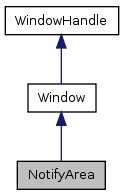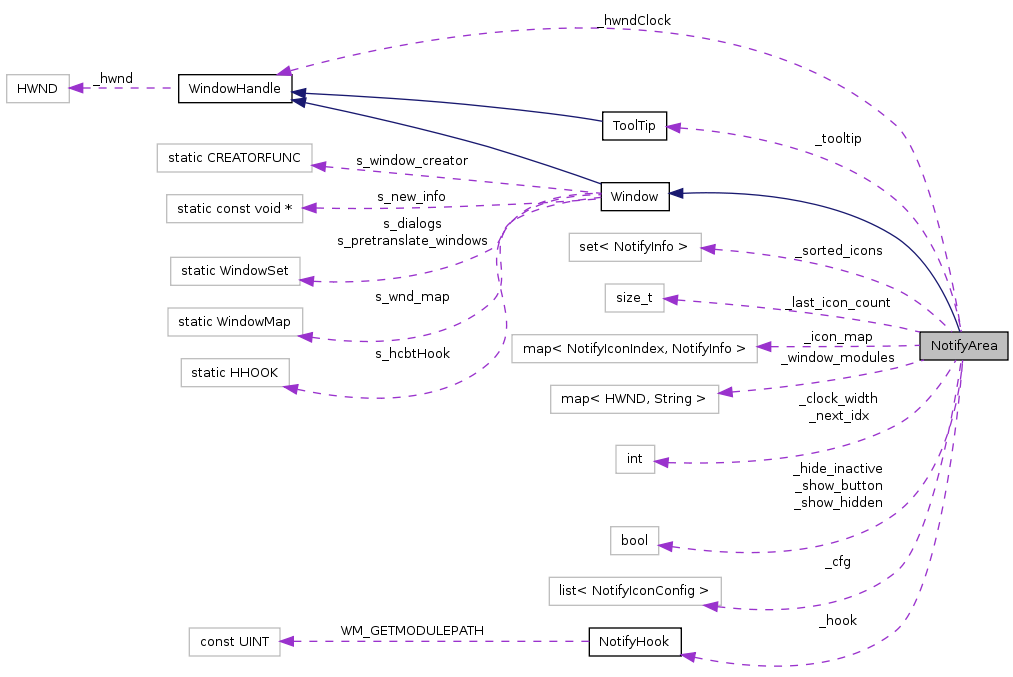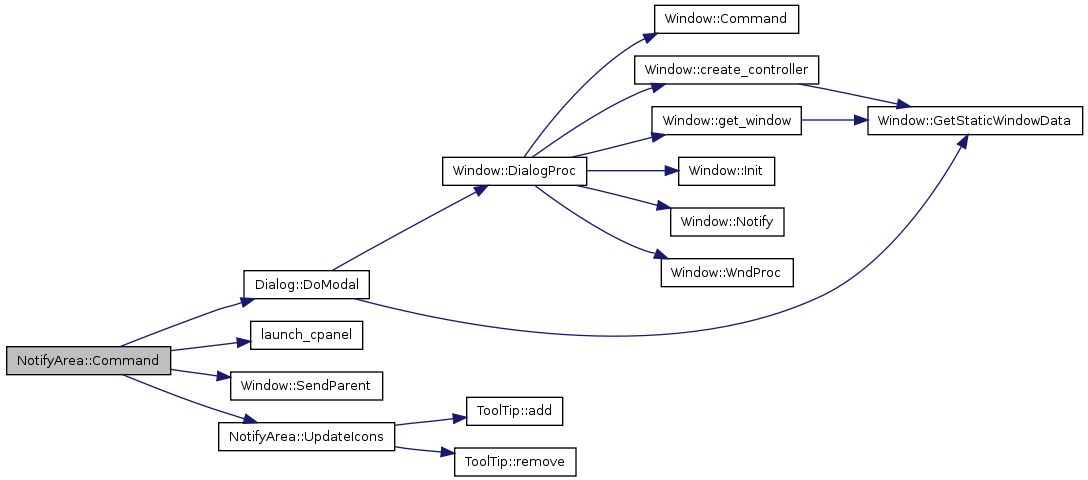tray notification area aka "tray" More...
#include <traynotify.h>


Public Types | |
| typedef Window | super |
Public Member Functions | |
| NotifyArea (HWND hwnd) | |
| ~NotifyArea () | |
| LRESULT | ProcessTrayNotification (int notify_code, NOTIFYICONDATA *pnid) |
Static Public Member Functions | |
| static HWND | Create (HWND hwndParent) |
Protected Member Functions | |
| LRESULT | Init (LPCREATESTRUCT pcs) |
| LRESULT | WndProc (UINT nmsg, WPARAM wparam, LPARAM lparam) |
| int | Command (int id, int code) |
| int | Notify (int id, NMHDR *pnmh) |
| void | UpdateIcons () |
| void | Paint () |
| void | Refresh (bool do_refresh=false) |
| void | CancelModes () |
| NotifyIconSet::iterator | IconHitTest (const POINT &pos) |
| search for a icon at a given client coordinate position | |
| bool | DetermineHideState (NotifyInfo &entry) |
| void | read_config () |
| void | write_config () |
| void | show_clock (bool flag) |
Protected Attributes | |
| WindowHandle | _hwndClock |
| int | _clock_width |
| ToolTip | _tooltip |
| NotifyHook | _hook |
| bool | _show_hidden |
| bool | _hide_inactive |
| bool | _show_button |
| NotifyIconCfgList | _cfg |
| map< HWND, String > | _window_modules |
| NotifyIconMap | _icon_map |
| NotifyIconSet | _sorted_icons |
| int | _next_idx |
| size_t | _last_icon_count |
Friends | |
| struct | TrayNotifyDlg |
Detailed Description
tray notification area aka "tray"
Definition at line 130 of file traynotify.h.
Member Typedef Documentation
| typedef Window NotifyArea::super |
Definition at line 132 of file traynotify.h.
Constructor & Destructor Documentation
| NotifyArea::NotifyArea | ( | HWND | hwnd ) |
Definition at line 209 of file traynotify.cpp.
References _clock_width, _hide_inactive, _last_icon_count, _next_idx, _show_button, and _show_hidden.
: super(hwnd), _tooltip(hwnd) { _next_idx = 0; _clock_width = 0; _last_icon_count = 0; _show_hidden = false; _hide_inactive = true; _show_button = true; }
| NotifyArea::~NotifyArea | ( | ) |
Definition at line 221 of file traynotify.cpp.
References WindowHandle::_hwnd, and write_config().
{
KillTimer(_hwnd, 0);
write_config();
}

Member Function Documentation
| void NotifyArea::CancelModes | ( | ) | [protected] |
Reimplemented from Window.
Definition at line 579 of file traynotify.cpp.
References _sorted_icons.
Referenced by WndProc().
{
PostMessage(HWND_BROADCAST, WM_CANCELMODE, 0, 0);
for(NotifyIconSet::const_iterator it=_sorted_icons.begin(); it!=_sorted_icons.end(); ++it)
PostMessage(it->_hWnd, WM_CANCELMODE, 0, 0);
}

| int NotifyArea::Command | ( | int | id, |
| int | code | ||
| ) | [protected, virtual] |
Reimplemented from Window.
Definition at line 518 of file traynotify.cpp.
References WindowHandle::_hwnd, _show_button, _show_hidden, Dialog::DoModal(), ID_CONFIG_NOTIFYAREA, ID_CONFIG_TIME, ID_SHOW_HIDDEN_ICONS, ID_SHOW_ICON_BUTTON, IDD_NOTIFYAREA, launch_cpanel(), Window::SendParent(), TEXT, UpdateIcons(), and WINDOW_CREATOR.
{
switch(id) {
case ID_SHOW_HIDDEN_ICONS:
_show_hidden = !_show_hidden;
UpdateIcons();
break;
case ID_SHOW_ICON_BUTTON:
_show_button = !_show_button;
UpdateIcons();
break;
case ID_CONFIG_NOTIFYAREA:
Dialog::DoModal(IDD_NOTIFYAREA, WINDOW_CREATOR(TrayNotifyDlg), GetParent(_hwnd));
break;
case ID_CONFIG_TIME:
launch_cpanel(_hwnd, TEXT("timedate.cpl"));
break;
default:
SendParent(WM_COMMAND, MAKELONG(id,code), 0);
}
return 0;
}

Definition at line 374 of file traynotify.cpp.
References CLASSNAME_TRAYNOTIFY, NOTIFYAREA_WIDTH_DEF, TITLE_TRAYNOTIFY, and WINDOW_CREATOR.
Referenced by show_clock().
{
static BtnWindowClass wcTrayNotify(CLASSNAME_TRAYNOTIFY, CS_DBLCLKS);
ClientRect clnt(hwndParent);
return Window::Create(WINDOW_CREATOR(NotifyArea), WS_EX_STATICEDGE,
wcTrayNotify, TITLE_TRAYNOTIFY, WS_CHILD|WS_VISIBLE|WS_CLIPCHILDREN,
clnt.right-(NOTIFYAREA_WIDTH_DEF+1), 1, NOTIFYAREA_WIDTH_DEF, clnt.bottom-2, hwndParent);
}

| bool NotifyArea::DetermineHideState | ( | NotifyInfo & | entry ) | [protected] |
| NotifyIconSet::iterator NotifyArea::IconHitTest | ( | const POINT & | pos ) | [protected] |
search for a icon at a given client coordinate position
Definition at line 802 of file traynotify.cpp.
References _show_button, _sorted_icons, NOTIFYICON_DIST, NOTIFYICON_SIZE, NOTIFYICON_X, and NOTIFYICON_Y.
Referenced by Notify(), and WndProc().
{
if (pos.y<NOTIFYICON_Y || pos.y>=NOTIFYICON_Y+NOTIFYICON_SIZE)
return _sorted_icons.end();
NotifyIconSet::iterator it = _sorted_icons.begin();
int x = NOTIFYICON_X;
if (_show_button)
x += NOTIFYICON_DIST;
for(; it!=_sorted_icons.end(); ++it) {
//NotifyInfo& entry = const_cast<NotifyInfo&>(*it); // Why does GCC 3.3 need this additional const_cast ?!
if (pos.x>=x && pos.x<x+NOTIFYICON_SIZE)
break;
x += NOTIFYICON_DIST;
}
return it;
}

| LRESULT NotifyArea::Init | ( | LPCREATESTRUCT | pcs ) | [protected, virtual] |
Reimplemented from Window.
Definition at line 362 of file traynotify.cpp.
References WindowHandle::_hwnd, Window::Init(), and read_config().
{
if (super::Init(pcs))
return 1;
read_config();
SetTimer(_hwnd, 0, 1000, NULL);
return 0;
}

| int NotifyArea::Notify | ( | int | id, |
| NMHDR * | pnmh | ||
| ) | [protected, virtual] |
Reimplemented from Window.
Definition at line 546 of file traynotify.cpp.
References WindowHandle::_hwnd, _show_button, _show_hidden, _sorted_icons, NotifyIconConfig::_tipText, IconHitTest(), IDS_HIDE_ICONS, IDS_SHOW_HIDDEN_ICONS, NOTIFYICON_SIZE, NOTIFYICON_X, NOTIFYICON_Y, ScreenToClient(), and String::str().
{
if (pnmh->code == TTN_GETDISPINFO) {
LPNMTTDISPINFO pdi = (LPNMTTDISPINFO)pnmh;
Point pt(GetMessagePos());
ScreenToClient(_hwnd, &pt);
if (_show_button &&
pt.x>=NOTIFYICON_X && pt.x<NOTIFYICON_X+NOTIFYICON_SIZE &&
pt.y>=NOTIFYICON_Y && pt.y<NOTIFYICON_Y+NOTIFYICON_SIZE)
{
static ResString sShowIcons(IDS_SHOW_HIDDEN_ICONS);
static ResString sHideIcons(IDS_HIDE_ICONS);
pdi->lpszText = (_show_hidden? sHideIcons: sShowIcons).str();
} else {
NotifyIconSet::iterator found = IconHitTest(pt);
if (found != _sorted_icons.end()) {
NotifyInfo& entry = const_cast<NotifyInfo&>(*found); // Why does GCC 3.3 need this additional const_cast ?!
// enable multiline tooltips (break at CR/LF and for very long one-line strings)
SendMessage(pnmh->hwndFrom, TTM_SETMAXTIPWIDTH, 0, 400);
pdi->lpszText = entry._tipText.str();
}
}
}
return 0;
}

| void NotifyArea::Paint | ( | ) | [protected] |
Definition at line 710 of file traynotify.cpp.
References WindowHandle::_hwnd, _show_button, _show_hidden, _sorted_icons, IDI_NOTIFY_L, IDI_NOTIFY_R, NOTIFYICON_DIST, NOTIFYICON_SIZE, NOTIFYICON_X, and NOTIFYICON_Y.
Referenced by WndProc().
{
BufferedPaintCanvas canvas(_hwnd);
// first fill with the background color
FillRect(canvas, &canvas.rcPaint, GetSysColorBrush(COLOR_BTNFACE));
// draw icons
int x = NOTIFYICON_X;
int y = NOTIFYICON_Y;
if (_show_button) {
static SmallIcon leftArrowIcon(IDI_NOTIFY_L);
static SmallIcon rightArrowIcon(IDI_NOTIFY_R);
DrawIconEx(canvas, x, y, _show_hidden?rightArrowIcon:leftArrowIcon, NOTIFYICON_SIZE, NOTIFYICON_SIZE, 0, 0, DI_NORMAL);
x += NOTIFYICON_DIST;
}
#ifndef _NO_ALPHABLEND
MemCanvas mem_dc;
SelectedBitmap bmp(mem_dc, CreateCompatibleBitmap(canvas, NOTIFYICON_SIZE, NOTIFYICON_SIZE));
RECT rect = {0, 0, NOTIFYICON_SIZE, NOTIFYICON_SIZE};
BLENDFUNCTION blend = {AC_SRC_OVER, 0, 128, 0}; // 50 % visible
#endif
for(NotifyIconSet::const_iterator it=_sorted_icons.begin(); it!=_sorted_icons.end(); ++it) {
#ifndef _NO_ALPHABLEND
if (it->_dwState & NIS_HIDDEN) {
FillRect(mem_dc, &rect, GetSysColorBrush(COLOR_BTNFACE));
DrawIconEx(mem_dc, 0, 0, it->_hIcon, NOTIFYICON_SIZE, NOTIFYICON_SIZE, 0, 0, DI_NORMAL);
AlphaBlend(canvas, x, y, NOTIFYICON_SIZE, NOTIFYICON_SIZE, mem_dc, 0, 0, NOTIFYICON_SIZE, NOTIFYICON_SIZE, blend);
} else
#endif
DrawIconEx(canvas, x, y, it->_hIcon, NOTIFYICON_SIZE, NOTIFYICON_SIZE, 0, 0, DI_NORMAL);
x += NOTIFYICON_DIST;
}
}

| LRESULT NotifyArea::ProcessTrayNotification | ( | int | notify_code, |
| NOTIFYICONDATA * | pnid | ||
| ) |
- Todo:
- This is a fix for Windows Task Manager.
- Todo:
- call only if really changes occurred
Definition at line 587 of file traynotify.cpp.
References NotifyInfo::_dwState, WindowHandle::_hwnd, _icon_map, NotifyInfo::_idx, NotifyIconConfig::_mode, _next_idx, DetermineHideState(), NotifyInfo::modify(), NIM_HIDE, and UpdateIcons().
{
switch(notify_code) {
case NIM_ADD:
case NIM_MODIFY:
if ((int)pnid->uID >= 0) { ///@todo This is a fix for Windows Task Manager.
NotifyInfo& entry = _icon_map[pnid];
// a new entry?
if (entry._idx == -1)
entry._idx = ++_next_idx;
/* equivalent code using iterator::find();
NotifyIconMap::iterator found = _icon_map.find(pnid);
NotifyInfo* pentry;
// a new entry?
if (found == _icon_map.end()) {
pentry = &_icon_map[pnid];
pentry->_idx = ++_next_idx;
} else {
pentry = &found->second;
}
NotifyInfo& entry = *pentry;
*/
bool changes = entry.modify(pnid);
#if NOTIFYICON_VERSION>=3 // as of 21.08.2003 missing in MinGW headers
if (DetermineHideState(entry) && entry._mode==NIM_HIDE) {
entry._dwState |= NIS_HIDDEN;
changes = true;
}
#endif
if (changes)
UpdateIcons(); ///@todo call only if really changes occurred
return TRUE;
}
break;
case NIM_DELETE: {
NotifyIconMap::iterator found = _icon_map.find(pnid);
if (found != _icon_map.end()) {
if (found->second._hIcon)
DestroyIcon(found->second._hIcon);
_icon_map.erase(found);
UpdateIcons();
return TRUE;
}
break;}
#if NOTIFYICON_VERSION>=3 // as of 21.08.2003 missing in MinGW headers
case NIM_SETFOCUS:
SetForegroundWindow(_hwnd);
return TRUE;
case NIM_SETVERSION:
NotifyIconMap::iterator found = _icon_map.find(pnid);
if (found != _icon_map.end()) {
found->second._version = pnid->UNION_MEMBER(uVersion);
return TRUE;
} else
return FALSE;
#endif
}
return FALSE;
}

| void NotifyArea::read_config | ( | ) | [protected] |
- Todo:
- read default setting from registry
- Todo:
- read default setting from registry
Definition at line 248 of file traynotify.cpp.
References _cfg, _hide_inactive, NotifyIconConfig::_mode, NotifyIconConfig::_modulePath, NotifyIconConfig::_name, _show_button, _show_hidden, NotifyIconConfig::_tipText, NotifyIconConfig::_windowTitle, XMLStorage::XMLPos::back(), XMLStorage::XMLChildrenFilter::begin(), XMLStorage::XMLChildrenFilter::end(), g_Globals, XMLStorage::XMLNode::get(), ExplorerGlobals::get_cfg(), XMLStorage::XMLPos::go_down(), NIM_HIDE, NIM_SHOW, and show_clock().
Referenced by Init(), and WndProc().
{
bool clock_visible = true;
// read notification icon settings from XML configuration
XMLPos cfg_pos = g_Globals.get_cfg();
#ifndef __MINGW32__ // SHRestricted() missing in MinGW (as of 29.10.2003)
if (!g_Globals._SHRestricted || !SHRestricted(REST_HIDECLOCK))
#endif
{
if (cfg_pos.go_down("desktopbar")) {
clock_visible = XMLBoolRef(XMLPos(cfg_pos,"options"), "show-clock", !get_hide_clock_from_registry());
cfg_pos.back();
}
}
if (cfg_pos.go_down("notify-icons")) {
XMLPos options(cfg_pos, "options");
_hide_inactive = XMLBool(options, "hide-inactive", true); ///@todo read default setting from registry
_show_hidden = XMLBool(options, "show-hidden", false); ///@todo read default setting from registry
_show_button = XMLBool(options, "show-button", true);
XMLChildrenFilter icons(cfg_pos, "icon");
for(XMLChildrenFilter::iterator it=icons.begin(); it!=icons.end(); ++it) {
const XMLNode& node = **it;
NotifyIconConfig cfg;
cfg._name = node.get("name").c_str();
cfg._tipText = node.get("text").c_str();
cfg._windowTitle = node.get("window").c_str();
cfg._modulePath = node.get("module").c_str();
const string& mode = node.get("show");
if (mode == "show")
cfg._mode = NIM_SHOW;
else if (mode == "hide")
cfg._mode = NIM_HIDE;
else //if (mode == "auto")
cfg._mode = NIM_HIDE;
_cfg.push_back(cfg);
}
cfg_pos.back();
}
show_clock(clock_visible);
}


| void NotifyArea::Refresh | ( | bool | do_refresh = false ) |
[protected] |
Definition at line 750 of file traynotify.cpp.
References NotifyInfo::_dwState, _hide_inactive, NotifyIconIndex::_hWnd, _icon_map, NotifyInfo::_lastChange, NotifyIconConfig::_mode, _sorted_icons, DetermineHideState(), ICON_AUTOHIDE_SECONDS, NIM_AUTO, NIM_HIDE, NIM_SHOW, and UpdateIcons().
Referenced by WndProc().
{
// Look for task icons without valid owner window.
// This is an extended feature missing in MS Windows.
for(NotifyIconSet::const_iterator it=_sorted_icons.begin(); it!=_sorted_icons.end(); ++it) {
const NotifyInfo& entry = *it;
if (!IsWindow(entry._hWnd))
if (_icon_map.erase(entry)) // delete icons without valid owner window
++update;
}
DWORD now = GetTickCount();
// handle icon hiding
for(NotifyIconMap::iterator it=_icon_map.begin(); it!=_icon_map.end(); ++it) {
NotifyInfo& entry = it->second;
DetermineHideState(entry);
switch(entry._mode) {
case NIM_HIDE:
if (!(entry._dwState & NIS_HIDDEN)) {
entry._dwState |= NIS_HIDDEN;
++update;
}
break;
case NIM_SHOW:
if (entry._dwState&NIS_HIDDEN) {
entry._dwState &= ~NIS_HIDDEN;
++update;
}
break;
case NIM_AUTO:
// automatically hide icons after long periods of inactivity
if (_hide_inactive)
if (!(entry._dwState & NIS_HIDDEN))
if (now-entry._lastChange > ICON_AUTOHIDE_SECONDS*1000) {
entry._dwState |= NIS_HIDDEN;
++update;
}
break;
}
}
if (update)
UpdateIcons();
}


| void NotifyArea::show_clock | ( | bool | flag ) | [protected] |
Definition at line 339 of file traynotify.cpp.
References _clock_width, WindowHandle::_hwnd, _hwndClock, Create(), and PM_RESIZE_CHILDREN.
Referenced by read_config().
{
bool vis = _hwndClock!=0;
if (vis != flag) {
if (flag) {
// create clock window
_hwndClock = ClockWindow::Create(_hwnd);
if (_hwndClock) {
ClientRect clock_size(_hwndClock);
_clock_width = clock_size.right;
}
} else {
DestroyWindow(_hwndClock);
_hwndClock = 0;
_clock_width = 0;
}
SendMessage(GetParent(_hwnd), PM_RESIZE_CHILDREN, 0, 0);
}
}


| void NotifyArea::UpdateIcons | ( | ) | [protected] |
Definition at line 657 of file traynotify.cpp.
References NotifyInfo::_dwState, WindowHandle::_hwnd, _icon_map, _last_icon_count, _show_button, _show_hidden, _sorted_icons, _tooltip, ToolTip::add(), NOTIFYICON_DIST, NOTIFYICON_SIZE, NOTIFYICON_X, NOTIFYICON_Y, PM_RESIZE_CHILDREN, and ToolTip::remove().
Referenced by Command(), ProcessTrayNotification(), Refresh(), and WndProc().
{
_sorted_icons.clear();
// sort icon infos by display index
for(NotifyIconMap::const_iterator it=_icon_map.begin(); it!=_icon_map.end(); ++it) {
const NotifyInfo& entry = it->second;
#ifdef NIF_STATE // as of 21.08.2003 missing in MinGW headers
if (_show_hidden || !(entry._dwState & NIS_HIDDEN))
#endif
_sorted_icons.insert(entry);
}
// sync tooltip areas to current icon number
if (_sorted_icons.size() != _last_icon_count) {
RECT rect = {NOTIFYICON_X, NOTIFYICON_Y, NOTIFYICON_X+NOTIFYICON_SIZE, NOTIFYICON_Y+NOTIFYICON_SIZE};
size_t tt_idx = 0;
if (_show_button) {
_tooltip.add(_hwnd, tt_idx++, rect);
rect.left += NOTIFYICON_DIST;
rect.right += NOTIFYICON_DIST;
}
size_t icon_cnt = _sorted_icons.size();
while(tt_idx < icon_cnt) {
_tooltip.add(_hwnd, tt_idx++, rect);
rect.left += NOTIFYICON_DIST;
rect.right += NOTIFYICON_DIST;
}
while(tt_idx < _last_icon_count)
_tooltip.remove(_hwnd, tt_idx++);
_last_icon_count = _sorted_icons.size();
}
SendMessage(GetParent(_hwnd), PM_RESIZE_CHILDREN, 0, 0);
InvalidateRect(_hwnd, NULL, FALSE); // refresh icon display
UpdateWindow(_hwnd);
}


| LRESULT NotifyArea::WndProc | ( | UINT | nmsg, |
| WPARAM | wparam, | ||
| LPARAM | lparam | ||
| ) | [protected, virtual] |
Reimplemented from Window.
Definition at line 385 of file traynotify.cpp.
References _clock_width, _hook, NotifyIconIndex::_hWnd, WindowHandle::_hwnd, _hwndClock, _icon_map, _show_button, _show_hidden, _sorted_icons, NotifyInfo::_uCallbackMessage, NotifyIconIndex::_uID, _window_modules, CancelModes(), GET_WINDOW, HWND, IconHitTest(), ID_SHOW_HIDDEN_ICONS, ID_SHOW_ICON_BUTTON, IDM_NOTIFYAREA, NotifyHook::ModulePathCopyData(), NOTIFYAREA_SPACE, NOTIFYICON_DIST, NOTIFYICON_SIZE, NOTIFYICON_X, NOTIFYICON_Y, Paint(), PM_GET_WIDTH, PM_REFRESH, PM_REFRESH_CONFIG, read_config(), Refresh(), ScreenToClient(), TEXT, ClockWindow::TimerTick(), PopupMenu::TrackPopupMenu(), UpdateIcons(), and Window::WndProc().
{
switch(nmsg) {
case WM_PAINT:
Paint();
break;
case WM_TIMER: {
Refresh();
ClockWindow* clock_window = GET_WINDOW(ClockWindow, _hwndClock);
if (clock_window)
clock_window->TimerTick();
break;}
case PM_REFRESH:
Refresh(true);
break;
case WM_SIZE: {
int cx = LOWORD(lparam);
SetWindowPos(_hwndClock, 0, cx-_clock_width, 0, 0, 0, SWP_NOSIZE|SWP_NOZORDER|SWP_NOACTIVATE);
break;}
case PM_GET_WIDTH: {
int w = _sorted_icons.size()*NOTIFYICON_DIST + NOTIFYAREA_SPACE + _clock_width;
if (_show_button)
w += NOTIFYICON_DIST;
return w;}
case PM_REFRESH_CONFIG:
read_config();
break;
case WM_CONTEXTMENU: {
Point pt(lparam);
POINTS p;
p.x = (SHORT) pt.x;
p.y = (SHORT) pt.y;
ScreenToClient(_hwnd, &pt);
if (IconHitTest(pt) == _sorted_icons.end()) { // display menu only when no icon clicked
PopupMenu menu(IDM_NOTIFYAREA);
SetMenuDefaultItem(menu, 0, MF_BYPOSITION);
CheckMenuItem(menu, ID_SHOW_HIDDEN_ICONS, MF_BYCOMMAND|(_show_hidden?MF_CHECKED:MF_UNCHECKED));
CheckMenuItem(menu, ID_SHOW_ICON_BUTTON, MF_BYCOMMAND|(_show_button?MF_CHECKED:MF_UNCHECKED));
menu.TrackPopupMenu(_hwnd, p);
}
break;}
case WM_COPYDATA: { // receive NotifyHook answers
String path;
HWND hwnd;
if (_hook.ModulePathCopyData(lparam, &hwnd, path))
_window_modules[hwnd] = path;
break;}
default:
if (nmsg>=WM_MOUSEFIRST && nmsg<=WM_MOUSELAST) {
// close startup menu and other popup menus
// This functionality is missing in MS Windows.
if (nmsg==WM_LBUTTONDOWN || nmsg==WM_MBUTTONDOWN || nmsg==WM_RBUTTONDOWN
#ifdef WM_XBUTTONDOWN
|| nmsg==WM_XBUTTONDOWN
#endif
)
CancelModes();
Point pt(lparam);
NotifyIconSet::const_iterator found = IconHitTest(pt);
if (found != _sorted_icons.end()) {
const NotifyInfo& entry = const_cast<NotifyInfo&>(*found); // Why does GCC 3.3 need this additional const_cast ?!
// set activation time stamp
if (nmsg == WM_LBUTTONDOWN || // Some programs need PostMessage() instead of SendMessage().
nmsg == WM_MBUTTONDOWN || // So call SendMessage() only for BUTTONUP and BLCLK messages
#ifdef WM_XBUTTONDOWN
nmsg == WM_XBUTTONDOWN ||
#endif
nmsg == WM_RBUTTONDOWN) {
_icon_map[entry]._lastChange = GetTickCount();
}
// Notify the message if the owner is still alive
if (IsWindow(entry._hWnd)) {
if (nmsg == WM_MOUSEMOVE || // avoid to call blocking SendMessage() for merely moving the mouse over icons
nmsg == WM_LBUTTONDOWN || // Some programs need PostMessage() instead of SendMessage().
nmsg == WM_MBUTTONDOWN || // So call SendMessage() only for BUTTONUP and BLCLK messages
#ifdef WM_XBUTTONDOWN
nmsg == WM_XBUTTONDOWN ||
#endif
nmsg == WM_RBUTTONDOWN)
PostMessage(entry._hWnd, entry._uCallbackMessage, entry._uID, nmsg);
else {
// allow SetForegroundWindow() in client process
DWORD pid;
if (GetWindowThreadProcessId(entry._hWnd, &pid)) {
// bind dynamically to AllowSetForegroundWindow() to be compatible to WIN98
static DynamicFct<BOOL(WINAPI*)(DWORD)> AllowSetForegroundWindow(TEXT("USER32"), "AllowSetForegroundWindow");
if (AllowSetForegroundWindow)
(*AllowSetForegroundWindow)(pid);
}
// use PostMessage() for notifcation icons of Shell Service Objects in the own process
if (pid == GetCurrentProcessId())
PostMessage(entry._hWnd, entry._uCallbackMessage, entry._uID, nmsg);
else
SendMessage(entry._hWnd, entry._uCallbackMessage, entry._uID, nmsg);
}
}
else if (_icon_map.erase(entry)) // delete icons without valid owner window
UpdateIcons();
} else
// handle clicks on notification area button "show hidden icons"
if (_show_button)
if (nmsg == WM_LBUTTONDOWN)
if (pt.x>=NOTIFYICON_X && pt.x<NOTIFYICON_X+NOTIFYICON_SIZE &&
pt.y>=NOTIFYICON_Y && pt.y<NOTIFYICON_Y+NOTIFYICON_SIZE)
PostMessage(_hwnd, WM_COMMAND, MAKEWPARAM(ID_SHOW_HIDDEN_ICONS,0), 0);
}
return super::WndProc(nmsg, wparam, lparam);
}
return 0;
}

| void NotifyArea::write_config | ( | ) | [protected] |
Definition at line 301 of file traynotify.cpp.
References _cfg, _hide_inactive, _hwndClock, NotifyIconConfig::_mode, NotifyIconConfig::_modulePath, NotifyIconConfig::_name, _show_button, _show_hidden, NotifyIconConfig::_tipText, NotifyIconConfig::_windowTitle, XMLStorage::XMLPos::back(), NotifyIconConfig::create_name(), g_Globals, ExplorerGlobals::get_cfg(), XMLStorage::XMLPos::smart_create(), and string_from_mode().
Referenced by ~NotifyArea().
{
// write notification icon settings to XML configuration file
XMLPos cfg_pos = g_Globals.get_cfg();
cfg_pos.smart_create("desktopbar");
XMLBoolRef boolRef(XMLPos(cfg_pos,"options"), "show-clock");
boolRef = _hwndClock!=0;
cfg_pos.back();
cfg_pos.smart_create("notify-icons");
XMLPos options(cfg_pos, "options");
XMLBoolRef(options, "hide-inactive") = _hide_inactive;
XMLBoolRef(options, "show-hidden") = _show_hidden;
XMLBoolRef(options, "show-button") = _show_button;
for(NotifyIconCfgList::iterator it=_cfg.begin(); it!=_cfg.end(); ++it) {
NotifyIconConfig& cfg = *it;
// search for the corresponding node using the original name
cfg_pos.smart_create("icon", "name", cfg._name);
// refresh unique name
cfg.create_name();
cfg_pos["name"] = cfg._name.c_str();
cfg_pos["text"] = cfg._tipText.c_str();
cfg_pos["window"] = cfg._windowTitle.c_str();
cfg_pos["module"] = cfg._modulePath.c_str();
cfg_pos["show"] = string_from_mode(cfg._mode).c_str();
cfg_pos.back();
}
cfg_pos.back(); // smart_create
}


Friends And Related Function Documentation
friend struct TrayNotifyDlg [friend] |
Definition at line 168 of file traynotify.h.
Member Data Documentation
NotifyIconCfgList NotifyArea::_cfg [protected] |
Definition at line 170 of file traynotify.h.
Referenced by TrayNotifyDlg::Command(), read_config(), TrayNotifyDlg::Refresh(), TrayNotifyDlg::SetIconMode(), TrayNotifyDlg::TrayNotifyDlg(), and write_config().
int NotifyArea::_clock_width [protected] |
Definition at line 143 of file traynotify.h.
Referenced by NotifyArea(), show_clock(), and WndProc().
bool NotifyArea::_hide_inactive [protected] |
Definition at line 149 of file traynotify.h.
Referenced by NotifyArea(), read_config(), Refresh(), and write_config().
NotifyHook NotifyArea::_hook [protected] |
Definition at line 146 of file traynotify.h.
Referenced by WndProc().
WindowHandle NotifyArea::_hwndClock [protected] |
Definition at line 142 of file traynotify.h.
Referenced by show_clock(), WndProc(), and write_config().
NotifyIconMap NotifyArea::_icon_map [protected] |
Definition at line 174 of file traynotify.h.
Referenced by TrayNotifyDlg::Command(), ProcessTrayNotification(), TrayNotifyDlg::Refresh(), Refresh(), TrayNotifyDlg::TrayNotifyDlg(), UpdateIcons(), and WndProc().
size_t NotifyArea::_last_icon_count [protected] |
Definition at line 177 of file traynotify.h.
Referenced by NotifyArea(), and UpdateIcons().
int NotifyArea::_next_idx [protected] |
Definition at line 176 of file traynotify.h.
Referenced by NotifyArea(), and ProcessTrayNotification().
bool NotifyArea::_show_button [protected] |
Definition at line 150 of file traynotify.h.
Referenced by Command(), IconHitTest(), Notify(), NotifyArea(), Paint(), read_config(), UpdateIcons(), WndProc(), and write_config().
bool NotifyArea::_show_hidden [protected] |
Definition at line 148 of file traynotify.h.
Referenced by TrayNotifyDlg::Command(), Command(), Notify(), NotifyArea(), Paint(), read_config(), TrayNotifyDlg::Refresh(), TrayNotifyDlg::TrayNotifyDlg(), UpdateIcons(), WndProc(), and write_config().
NotifyIconSet NotifyArea::_sorted_icons [protected] |
Definition at line 175 of file traynotify.h.
Referenced by CancelModes(), IconHitTest(), Notify(), Paint(), Refresh(), UpdateIcons(), and WndProc().
ToolTip NotifyArea::_tooltip [protected] |
Definition at line 145 of file traynotify.h.
Referenced by UpdateIcons().
map<HWND, String> NotifyArea::_window_modules [protected] |
Definition at line 172 of file traynotify.h.
Referenced by WndProc().
The documentation for this struct was generated from the following files:

